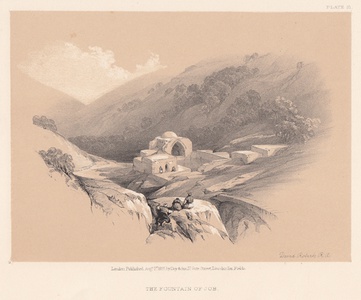| Method | Lithograph with tint stone |
| Artist | after David Roberts |
| Published | London, Published Augt. 1st. 1855, by Day & Son, 17, Gate Street, Lincoln's Inn Fields |
| Dimensions | Image 129 x 176 mm, Sheet 204 x 285 mm |
| Notes |
Plate 21 from Volume 1 of the small format reprint of Roberts' The Holy Land, Syria, Idumea, Arabia, Egypt & Nubia. A view of a fountain house in Gehenna, the Valley of Hinnom outside Jerusalem. The fountain house is identified by Roberts as the 'Fountain of Job,' obviously reporting a local folk tradition that this was the site where God blessed Job after his trails by granting him use of a 'fountain of youth,' which cured his maladies and restored him to his former strength. Numerous local traditions for the location of Job's fountain exist across the Holy Land, and it is likely that this fountain house is actually an ancient mikveh, a pool used in Hebrew ritual purification. The valley of Gehenna had many negative connections in the biblical era, and was seen as a place akin to the Christian Hell, where the souls of the wicked would be sent after judgement. It was associated with child sacrifice, devil worship, and fire. In Roberts' view, the fountain house is shown at the centre of the valley, with two guards resting beside its arched entrance door. In the foreground, three men climb a rocky outcrop which overlooks the valley and a narrow bridge which spans the chasm between them and the fountain. David Roberts RA (24th October 1796 – 25th November 1864) was a Scottish painter. He is especially known for a prolific series of detailed prints of Egypt and the Near East produced during the 1840s from sketches made during long tours of the region (1838-1840). This work, and his large oil paintings of similar subjects, made him a prominent Orientalist painter. He was elected as a Royal Academician in 1841. The firm of Day & Haghe was one of the most prominent lithographic companies of the nineteenth-century. They were also amongst the foremost pioneers in the evolution of chromolithography. The firm was established in 1823 by William Day, but did not trade under the moniker of Day & Haghe until the arrival of Louis Haghe in 1831. In 1838, Day & Haghe were appointed as Lithographers to the Queen. However, and perhaps owing to the fact that there was never a formal partnership between the two, Haghe left the firm in the 1850's to devote himself to watercolour painting. The firm continued as Day & Son under the guidance of William Day the younger (1823 - 1906) but, as a result of a scandal involving Lajos Kossuth, was forced into liquidation in 1867. Vincent Brookes bought the company in the same year, and would produce the caricatures for Gibson Bowles' Vanity Fair magazine, as well as the illustrations for Cassells's Poultry Book, amongst other commissions. Condition: Light foxing to margins, not affecting image. |
| Framing | unmounted |
| Price | £25.00 |
| Stock ID | 39336 |

